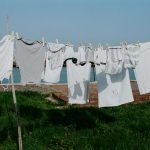When choosing between polyester and nylon, you’ll want to contemplate how each fabric handles breathability since it directly impacts your comfort. Both are popular in activewear, but they perform quite differently when it comes to moisture management and airflow. Understanding these differences can help you pick the right material for your needs, whether you’re hitting the gym or heading outdoors. But what exactly sets their breathability apart?
Table of Contents
Key Takeaways
- Polyester generally offers better breathability due to a more open fiber arrangement compared to nylon’s tighter weave.
- Nylon’s dense weave often traps heat and moisture, reducing overall airflow and comfort.
- Polyester excels at moisture wicking, keeping skin dry and enhancing breathability during physical activities.
- Weaving techniques impact breathability; loose weaves like mesh improve airflow more than tight plain weaves.
- Nylon is more durable and abrasion-resistant but less effective in moisture management and breathability than polyester.
Understanding Breathability in Synthetic Fabrics
Breathability plays an essential role in how comfortable synthetic fabrics feel against your skin. When you pick out polyester or nylon, you’ll want to take into account breathability factors like fiber structure, fabric weight, and weave tightness.
These elements determine how well air circulates and moisture escapes, which directly impacts your comfort. Fabric comparisons reveal that even though both fibers are synthetic, their breathability can differ notably.
For instance, nylon’s tighter weave often traps more heat, while polyester’s structure might allow better airflow. Understanding these differences helps you choose the best fabric based on your activity level and environment.
Comparing Moisture Wicking Between Polyester and Nylon
Although both polyester and nylon are popular choices for activewear, they differ considerably in how they handle moisture.
When you look at moisture management, polyester excels at wicking sweat away from your skin, drying quickly to keep you feeling dry during intense workouts.
Nylon, on the other hand, absorbs more moisture but dries slower, which might leave you feeling damp longer.
In a fabric comparison, polyester’s hydrophobic nature makes it superior for moisture wicking, making it ideal if you prioritize staying dry.
Nylon’s moisture retention can sometimes cause clamminess, but it’s more durable and resistant to abrasion.
Fabric Properties Affecting Airflow and Comfort
Since airflow plays an essential role in your comfort during physical activity, understanding how fabric properties influence ventilation can help you make better choices.
Both polyester and nylon offer strong fabric durability, but their fiber structure affects how air moves through the material. Polyester tends to have a slightly more open fiber arrangement, improving breathability and keeping you cooler.
Comfort factors like softness, stretch, and moisture management also come into play—polyester often feels lighter and dries faster, while nylon is smoother and more resistant to abrasion.
When choosing between them, consider how these properties balance durability with airflow to suit your activity level.
Picking the right fabric means you’ll stay comfortable, dry, and supported throughout your workout or daily wear.
How Weaving Techniques Influence Breathability
The way fabric is woven directly affects how air flows through it, impacting your comfort just as much as the fiber type.
Different weaving patterns create unique fabric structures that either enhance or restrict breathability. For example, a plain weave forms a tight, dense fabric structure, limiting airflow and trapping heat.
On the other hand, a loose weave like a mesh or a knit allows more space between threads, promoting better ventilation and moisture evaporation.
When choosing between polyester and nylon, don’t overlook how the weaving technique influences breathability.
Even the same fiber can feel vastly different based on its fabric structure.
Performance of Polyester and Nylon in Activewear
When you choose activewear, polyester and nylon often come up as top contenders because they both offer durability and moisture-wicking properties.
Understanding their performance can help you pick the best for your workouts. Here’s what you should know:
- Polyester performance shines in moisture management; it dries quickly, keeping you comfortable during intense exercise.
- Nylon advantages include superior strength and elasticity, which means your activewear resists wear and moves with you effortlessly.
- Both fabrics handle sweat well, but polyester tends to retain less odor, making it ideal for longer sessions.
Enhancing Breathability With Fabric Technology
Although natural breathability varies between polyester and nylon, fabric technology plays an essential role in enhancing airflow and moisture control.
You’ll find that fabric innovations, like micro-perforations and moisture-wicking coatings, greatly boost how these materials handle sweat and heat. These performance enhancements allow air to circulate better, keeping you cooler and drier during activity.
Additionally, advances such as mesh panels or engineered knit patterns improve ventilation without sacrificing durability.
When choosing between polyester and nylon, consider how these technological upgrades impact comfort rather than just the fibers themselves.
Practical Uses Based on Breathability and Durability
When choosing fabrics for your activewear, you’ll want to prioritize breathability to stay cool and comfortable.
For outdoor gear, durability takes the front seat to withstand tough conditions.
Let’s explore how polyester and nylon fit these practical needs.
Activewear: Breathability Priority
For activewear, choosing between polyester and nylon often comes down to how well each fabric manages breathability and durability during intense workouts.
You want gear that keeps you cool but also lasts. When evaluating activewear features, consider these breathability metrics:
- Moisture-wicking ability – Polyester excels here, pulling sweat away quickly to keep you dry.
- Air permeability – Nylon often allows better airflow, enhancing ventilation during high-intensity sessions.
- Stretch and recovery – Nylon’s elasticity supports movement without compromising breathability.
If your priority is staying dry, polyester might suit you best.
But if you value airflow and flexibility, nylon could be the better choice.
Understanding these differences helps you pick activewear that matches your workout needs without sacrificing comfort or performance.
Outdoor Gear: Durability Focus
Durability plays a critical role in choosing outdoor gear, especially when you need fabrics that withstand harsh conditions without sacrificing breathability. When comparing polyester and nylon, you’ll find nylon often leads in durability, resisting abrasions and tears better. Polyester, however, excels in moisture management, keeping you comfortable. Here’s a durability comparison highlighting outdoor performance factors:
| Feature | Polyester | Nylon |
|---|---|---|
| Abrasion Resistance | Moderate | High |
| Tear Strength | Moderate | High |
| Moisture Wicking | High | Moderate |
| UV Resistance | High | Moderate |
| Breathability | Moderate to High | Moderate |
Choosing nylon favors rugged durability, while polyester balances breathability and moisture control—key for diverse outdoor activities.
Frequently Asked Questions
How Do Polyester and Nylon Compare in Environmental Impact?
You’ll find both polyester and nylon have environmental impacts tied to their production processes, but recycling practices help reduce waste. Polyester’s recycling is more common, making it a slightly greener choice if you want to minimize your footprint.
Can Polyester or Nylon Cause Skin Allergies?
You can experience skin reactions from both polyester and nylon if you have material sensitivities. These synthetic fabrics sometimes cause irritation or allergies, so it’s wise to test them on a small patch of skin before wearing them extensively.
What Are the Care Instructions for Polyester vs. Nylon Garments?
You should follow specific care methods to keep polyester and nylon garments in good shape. Use gentle washing and avoid high heat to maintain fabric longevity. This helps your clothes last longer and stay comfortable.
How Do Polyester and Nylon Differ in Cost and Availability?
You’d think polyester costs a fortune, but it’s actually cheaper and more widely available than nylon. When you compare cost and market availability, polyester wins easily, making it a go-to choice for budget-conscious shoppers.
Are There Differences in Odor Retention Between Polyester and Nylon?
You’ll notice polyester tends to retain odor more than nylon, which might affect fabric longevity if not cleaned properly. Nylon generally resists smells better, helping keep your gear fresher and extending its usable life.
- How to Use Green Herringbone Fabric for a Touch of Earthy Elegance - June 19, 2025
- A Guide to Buying Herringbone Fabric by the Yard Online - June 19, 2025
- Is Herringbone a Good Fabric for Shirts? A Detailed Analysis - June 19, 2025






